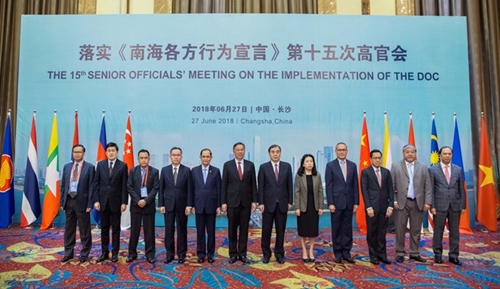The two sides have pledged to further develop their relations to a new high by adopting the China-ASEAN Strategic Partnership Vision 2030 last month, which is widely seen as a role model for cooperation in the Asia-Pacific region, the Xinhua News Agency reported.
In 2003, China and ASEAN decided to establish their strategic partnership, opening up a new chapter in the bilateral relations. Over the past 15 years, the partnership has endured a changing international landscape and theỉ cooperation has continued to deliver real benefits to the countries and the peoples of the region.
    |
 |
|
Heads of the delegations at the 15th ASEAN-China Senior Officials' Meeting on the Implementation of the DOC in Hunan province, China, on June 27 (Photo for illustration) |
China and ASEAN are firmly committed to good-neighborliness and friendship while enhancing political and security ties to create stability across the Asia-Pacific. Under this partnership, the two sides have properly managed sensitive issues and disputes through dialogue and negotiation in order to keep their relationship on track.
China and ASEAN have promoted trade and investment liberalization, an approach that has provided the backbone and engine for development and prosperity in the region.
The China-ASEAN Free Trade Area (FTA), the largest regional FTA in the world in terms of population, went into effect in 2010, removing tariffs on more than 90 percent of goods traded between China and 10 ASEAN members, namely Brunei, Cambodia, Indonesia, Laos, Malaysia, Myanmar, the Philippines, Singapore, Thailand and Vietnam.
Moreover, an updated FTA was hammered out late in 2015, further facilitating trade, scaling up bilateral investment and encouraging technological cooperation.
China and ASEAN are now working together to speed up negotiations of the Regional Comprehensive Economic Partnership (RCEP), a proposed free trade area made up of the 10 ASEAN member states and its six FTA partners - China, Australia, India, Japan, the Republic of Korea and New Zealand, in order to further facilitate trade and investment in the region.
Based on the principle of collaboration, China and ASEAN have worked to align the former's Belt and Road Initiative with the latter's development plans. Connectivity projects include the China-Laos Railway, the China-Thailand high-speed railway, and Indonesia's Jakarta-Bandung high-speed railway.
China and ASEAN have also advocated people-to-people exchanges and mutual learning among their different and numerous civilizations. Ties have rapidly developed in the areas of culture, education, tourism, media, science and technology, environmental protection, disaster relief, poverty reduction and youth, among others.
China and ASEAN adopted last month a blueprint to further advance their strategic partnership and forge wider mutual beneficial cooperation so as to build a closer China-ASEAN community with a shared future.
The vision is a new cooperation framework between China and ASEAN, underpinned by the three pillars of political and security cooperation, economic cooperation and people-to-people exchange, and supported by cooperation in mutually-agreed areas.
As the backbone and engine for promoting development and prosperity in the region, China and ASEAN hailed the continued strong growth in bilateral trade, investment and tourism flows.
The two sides have pledged to intensify efforts to meet the joint target of USD 1 trillion in trade and USD 150 billion in investment by 2020 through deepening economic linkages and improving connectivity with an eye on more fruitful results in trade and investment by 2030.
They also remained committed to intensifying efforts to finalize negotiations for a modern, comprehensive, high-quality and mutually-beneficial RCEP agreement, boosting physical and institutional connectivity to bring markets closer together, deepening financial cooperation, enhancing dialogue and exchanges in maritime economic cooperation, engaging in the process of economic globalization and facilitating further economic integration, among others.
Source: VNA